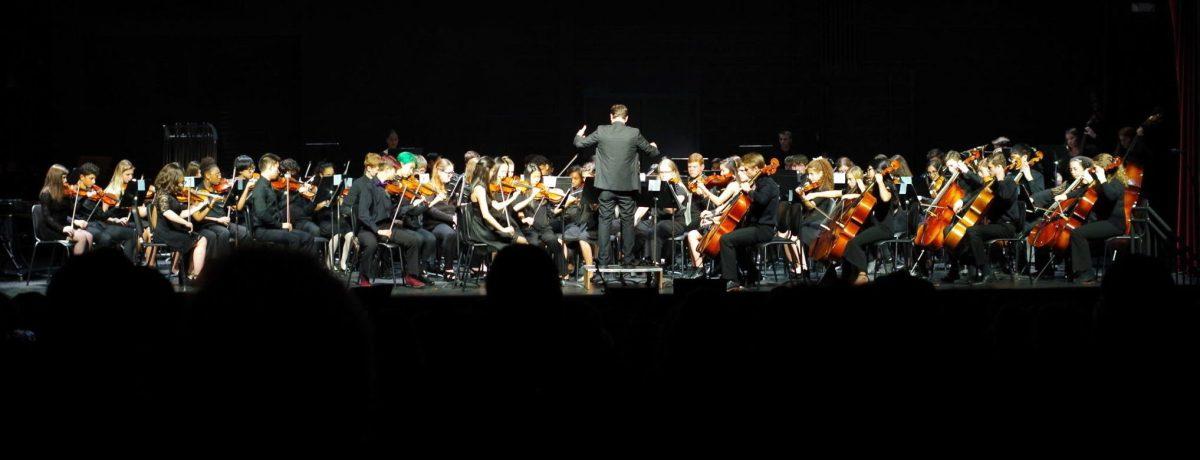Making the values taught by music mandatory
Contributing Writer Maggie Frank, ’20
In 2001, the United States agenda for STEM, originally SMET, education was created by the then governor of Arizona, Janet Napolitano. STEM education includes science, technology, engineering, and mathematics. But what happened to the arts? The arts were excluded from this original agenda. In 2006, middle/high school engineering and technology teacher Georgette Yakman developed the framework for STEAM education and a year later began implementation. STEAM has not yet been implemented nationwide, but the movement towards a STEAM framework is growing. STEAM should be implemented into all K-12 schools because it includes many types of art, including music, which provides some values that are different from the ones offered by STEM subjects and some that are continuations of STEM subjects.
Before we go any further, the distinction between STEM and STEAM, specifically the music part of STEAM, must be made. According to the Rhode Island School of Design, the purpose of STEAM is “combining the mind of a scientist or technologist with that of an artist or designer.” What this means is that in implementing STEAM, the importance of STEM subjects will not become insignificant. Rather, STEM subjects will hold the same importance, but the arts will be woven into the framework. It’s not about making a choice between STEM and, in this case, music- it’s about merging the two so that each is valued equally. In combining music and STEM, we can enhance the effectiveness of teaching STEM.
Comparing Music and STEM Values
STEM subjects teach creativity, inquiry skills, math and science skills, engineering-design thinking, critical thinking, and collaboration. The United States Department of Education stated that their goal with the implementation of STEM was “to promote student achievement and preparation for global competitiveness by fostering educational excellence and ensuring equal access.” The merging of music with these subjects will further enhance the values that are taught to our children in schools by reinforcing the shared values and teaching new ones as well.
Nurturing Individuality
Music and STEM subjects differ greatly when it comes to nurturing individuality. On one hand, STEM subjects are based on the preoccupation with answers that fit one mold. STEM subjects obsess over finding the correct answer, where music does not. Paul R. Lehman, who served as music specialist with the United States Department of Education in Washington, D.C., stated in his article, “Priorities and Pitfalls Of Music Education: An Open Letter,” that the fixation that STEM classes, and those that teach them, have on right answers “creates an artificial environment inconsistent with reality [that gives] student with a distorted view of the world.” Music encourages individuality whereas other disciplines, like STEM subjects, push all students to think uniformly.
Transcending the Barrier of Culture
Benjamin C. Willis, who served as the general chairman of the local convention committee for the 1953 MENC Eastern Division convention, stated that “[music is] a medium for understanding other people–their culture, and their problems”. One thing that Willis neglected to mention was that music removes the barrier that culture poses. I have experienced the elimination of this seemingly impenetrable language barrier first hand.
During the summer before my sophomore year, I went on a music tour to Europe with musicians from the entire east coast. We convened in Pennsylvania for two days to rehearse our music before we got on a plane to Europe. We spent about two weeks on tour, sightseeing and performing for crowds in different countries. As a musician, one of the most profound feelings is being able to connect with the audience through music. I was struck at how we were able to connect with our audiences through music even though none of us spoke Swedish, French, German, or Italian fluently. There was an unspoken understanding that was formed between us musicians and our audiences even though we came from completely different cultures. Music erased the barrier that culture had previously posed between us and our audience.
Should STEM be Valued Over Music?
Colby Porter, a member of the Jamesville-DeWitt High School band, points to two reasons why STEM subjects should be valued over music: the proportion of students who will go into music and the values that STEM provides. Porter stated that “while music education has an essential place in society, comparatively few students will go into music while STEM [subjects provide] skills that many will use in their careers.” Admittedly, the National Association for Music Education found that from 2011 to 2012, some 23% of U.S. undergraduates were enrolled in STEM fields while The College Music Society found that from 2009 to 2010, 1.7% of total student enrollment was in music.
However, this doesn’t mean that music education is not important. STEM subjects, just like music, have and teach different values. STEM subjects teach, among other things, inquiry, math, science, and critical thinking skills. Although there are values that are taught by music and not by STEM, there are also values that music provides that are not entirely separate from the values that STEM subjects provide. Both STEM subjects and music teach the value of critical thinking. It’s important that music education is incorporated into basic education through the implementation of a STEAM framework within schools because music builds upon, and adds to, the values that STEM subjects offer.
A Classical Argument
It is a common belief that music “distracts from academics” and “academic performance.” This implies that STEM subjects are the only ones that are academic ones and that, therefore, they are also the only ones that matter.
Rather than distracting from academics, music actually adds to academics because it helps students in, and further enhances the values that are taught by, STEM subjects. A study done by Päivi-Sisko Eerola and Tuomas Eerola found that there was a positive correlation between playing music and “the achievement and opportunity-factor and academic variables.” This means that those who received a music education scored higher on tests than those who didn’t.
It was originally believed by the American public that music, specifically classical music, made a person smarter. The first scientific proof that led to this supposed phenomenon was a study published byFrances H. Rauscher in 1993 in which she played 10 minutes of Mozart’s “Sonata for Two Pianos in D major, K. 448” to 36 college students, and then gave the students a test of spatial reasoning. She also had the same students listen to listening to 10 minutes of a person with a monotone speaking voice and then take a test of spatial reasoning. Rauscher found that “the students who had listened to the Mozart Sonata scored significantly higher on the spatial temporal task”. However, Rauscher stressed that the Mozart effect is “limited to spatial temporal reasoning and that there is no enhancement of general intelligence”. The public took this study out of context and the misconception that Mozart would “make your baby smarter” was formed.
Other studies have shown the same results as the ones found by Rauscher in 1993. These studies have also found that people who listened to Mozart showed significantly increased spatial reasoning skills for at least 10-15 minutes and that therefore classical music doesn’t actually permanently add points to one’s IQ. The same study done by Eerola also found that the students who played music also felt more confident in their schoolwork and generally scored better in math, literature and English.
Eerola’s experiment found that studying music does in fact provide “measurable social benefits.” Their study found that in comprehensive schools, where a music education is provided to everyone, “pupils in [these] classes were generally more satisfied with school life than pupils in the classes with a normal music education curriculum.” These findings support the claim from Willis, Lehman, and others; that music education provides social values.
The Social Value of Music
Participating in a band, orchestra, chorus, or small ensemble allows a person to make connections with people who have things in common with them. As a participant in concert band, full orchestra and pit band in school and plays the piano outside of school, I have met countless people and have been able to make countless friends. Playing an instrument has allowed me to travel the world. If I didn’t play an instrument, I wouldn’t have been able to experience these things. Will Guisbond, a senior at JDHS, stated that music is “an incredibly rewarding activity that fosters positive relationships for many involved.” Guisbond also stated that he had met some of his “closest friends through music.”
Being part of an ensemble also teaches a person to have a sense of greater responsibility towards a larger group. It also requires the cooperation of every member. If one person decides not to cooperate with the rest of the group, then the product will be weakened. In contrast, STEM classes usually revolves around individual work. Therefore, if one person in a STEM class decides not to do their homework, it doesn’t negatively affect the other students in the class because those students aren’t depending on each other. In his article, Willis also recognises this value, stating that “music offers an opportunity for self-expression through a group activity. Thus, it has a socializing value which is beneficial (…) [to learning] the importance of working as part of a group.” Along with the benefits mentioned by Willis, music also teaches a sense of responsibility for self and offers the opportunity for self-expression, self-development, and self-discovery through individual practise.
One of the most unique qualities of music is that it allows a person to discover and develop things about themselves that STEM subjects might not allow. Porter stated that “I think music education provides (…) [students with the ability to] feel connected with emotion. Students who learn to play an instrument or sing better are provided with a hugely important medium through which stress can be released.” Music should be integrated into the K-12 curriculum because it adds the value of working in a group that is not necessarily taught by STEM subjects.
Conclusion
A STEAM framework, which includes science, technology, engineering, arts and mathematics, should be integrated into the K-12 curriculum because music and other arts teaches multiple different values. It is because of these values that music education should be mandatory from kindergarten through 12th grade. The intrinsic values that are provided by music both differ from and reinforce the values that are taught by STEM subjects. The unique values that are brought to the table by music that help students to better understand themselves, and gain a sense of responsibility towards themselves and a group. The inherent value of learning how to function in a group setting is taught by both music and STEM subjects. By implementing a STEAM framework into K-12 curriculum, the values that are taught to our children can be expanded and enhanced.































